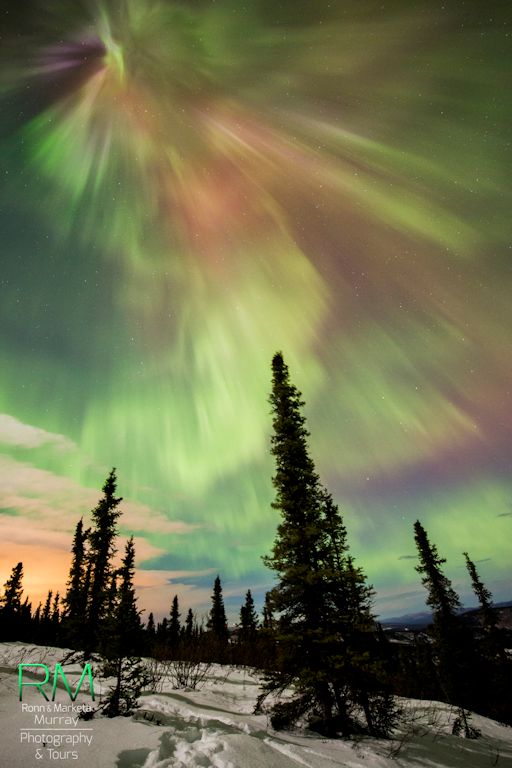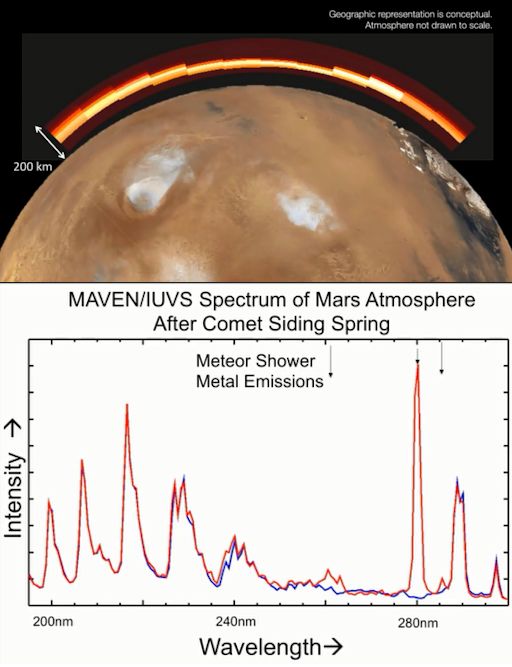Would you like a call when things are happening in the night sky? Sign up for backyard astronomy alerts from spaceweather.com: voice or text. | | | CHANCE OF FLARES: Sunspot AR2205 was mostly quiet over the weekend, but it still poses a threat for potent eruptions. NOAA forecasters estimate a 70% chance of M-class flares and a 30% chance of X-flares on Nov. 10th. Any eruptions will likely be geoeffective as the sunspot is directly facing Earth. Solar flare alerts: text, voice GENTLE IMPACT PRODUCES MINOR GEOMAGNETIC STORM: A CME sideswiped Earth's magnetic field on Nov. 10th. The impact was weak, yet nevertheless sparked a G1-class geomagnetic storm and auroras around the poles. Marketa S. Murray sends this picture from outside Fairbanks, Alaska: 
"We some 'Alaska rain' in Fairbanks this morning," says Murray. "Beautiful!" The CME that sparked the display traveled to Earth at about 600 km/s. As CMEs go, that is slow. Because the storm cloud was relatively plodding, it did not develop a shock wave at its leading edge--hence the weak impact and minor storm. Geomagnetic unrest should continue around the poles for the next 24 hours as CME effects subside. Arctic sky watchers, remain alert for auroras. Aurora alerts: text, voice Realtime Aurora Photo Gallery MARTIAN METEOR SHOWER: On Friday, NASA held a press conference to discuss what happened when Comet Siding Springs buzzed Mars on Oct. 19, 2014. An international fleet of Mars orbiters observed the encounter using a variety of cameras, radars, and other sensors. Among many findings, the highlight was a "spectacular meteor shower" detected by NASA's MAVEN spacecraft. MAVEN did not actually see streaks of light in the Martian atmosphere--the spacecraft was sheltering behind the body of Mars during the comet's flyby. But when MAVEN emerged, it found a glowing layer of Mg+ (a constituent of meteor smoke) floating 150 km above the planet's surface: 
The "smoke" was made of ionized magnesium and other metals shed by the disintegrating meteoroids. The data are consistent with "a few tons of comet dust being deposited in the atmosphere of Mars," says Nick Schneider, the instrument lead for MAVEN's Imaging Ultraviolet Spectrograph at University of Colorado, Boulder. "A human on the surface of Mars might have seen thousands of shooting stars per hour, possibly a meteor storm." He further speculated that the meteor shower would have produced a yellow afterglow in the skies of Mars because the meteor smoke was rich in sodium ions. Jim Green, the director of NASA's Planetary Science Division in Washington DC says there was a lot more comet dust hitting Mars than researchers expected, pre-flyby. Radars onboard the ESA's Mars Express spacecraft and NASA's Mars Reconnassance Orbiter also detected signs of meteor-related ions. MAVEN and the other spacecraft are continuing to collect data as the atmosphere of Mars recovers from the encounter. Realtime Comet Photo Gallery
Realtime Space Weather Photo Gallery
Realtime Eclipse Photo Gallery
Every night, a network of NASA all-sky cameras scans the skies above the United States for meteoritic fireballs. Automated software maintained by NASA's Meteoroid Environment Office calculates their orbits, velocity, penetration depth in Earth's atmosphere and many other characteristics. Daily results are presented here on Spaceweather.com. On Nov. 10, 2014, the network reported 23 fireballs.
(18 sporadics, 4 Northern Taurids, 1 omicron Eridanid)  In this diagram of the inner solar system, all of the fireball orbits intersect at a single point--Earth. The orbits are color-coded by velocity, from slow (red) to fast (blue). [Larger image] [movies] Potentially Hazardous Asteroids ( PHAs) are space rocks larger than approximately 100m that can come closer to Earth than 0.05 AU. None of the known PHAs is on a collision course with our planet, although astronomers are finding new ones all the time. On November 10, 2014 there were 1511 potentially hazardous asteroids. Notes: LD means "Lunar Distance." 1 LD = 384,401 km, the distance between Earth and the Moon. 1 LD also equals 0.00256 AU. MAG is the visual magnitude of the asteroid on the date of closest approach. | | The official U.S. government space weather bureau | | | The first place to look for information about sundogs, pillars, rainbows and related phenomena. | | | Researchers call it a "Hubble for the sun." SDO is the most advanced solar observatory ever. | | | 3D views of the sun from NASA's Solar and Terrestrial Relations Observatory | | | Realtime and archival images of the Sun from SOHO. | | | from the NOAA Space Environment Center | | | the underlying science of space weather | | 
